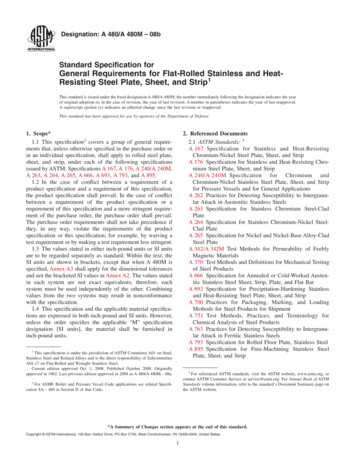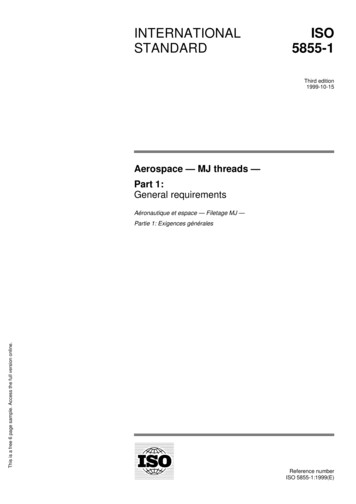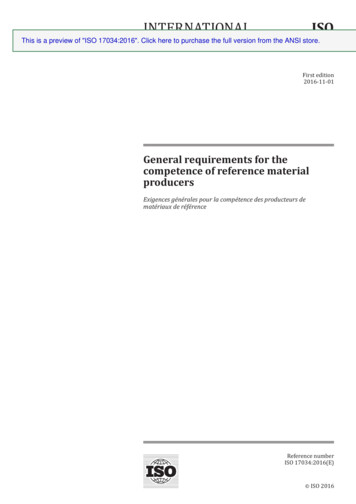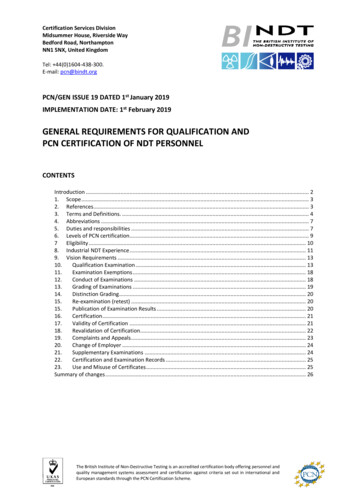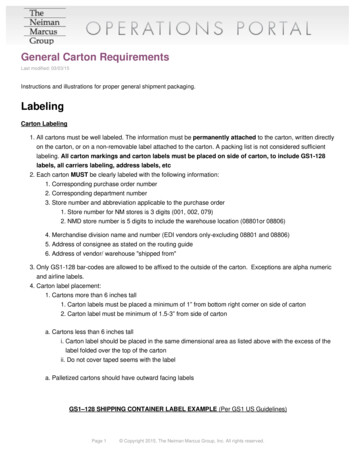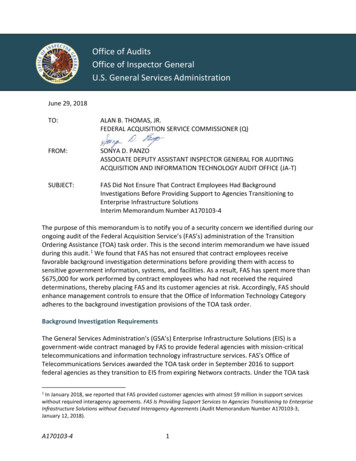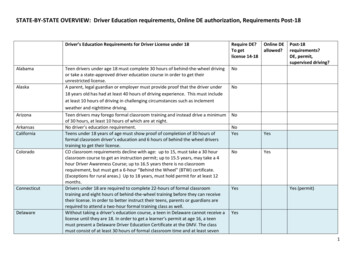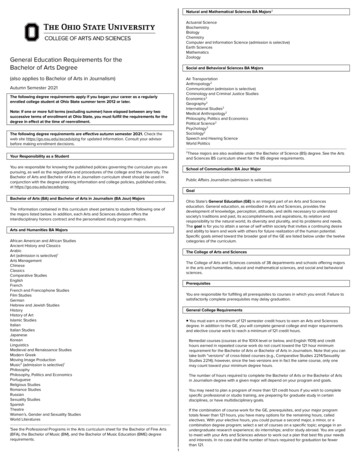
Transcription
Natural and Mathematical Sciences BA Majors2Actuarial ScienceBiochemistryBiologyChemistryComputer and Information Science (admission is selective)Earth SciencesMathematicsZoologyGeneral Education Requirements for theBachelor of Arts DegreeSocial and Behavioral Sciences BA Majors(also applies to Bachelor of Arts in Journalism)Air TransportationAnthropology2Communication (admission is selective)Criminology and Criminal Justice StudiesEconomics2Geography2International Studies2Medical Anthropology2Philosophy, Politics and EconomicsPolitical Science2Psychology2Sociology2Speech and Hearing ScienceWorld PoliticsAutumn Semester 2021The following degree requirements apply if you began your career as a regularlyenrolled college student at Ohio State summer term 2012 or later.Note: if one or more full terms (excluding summer) have elapsed between any twosuccessive terms of enrollment at Ohio State, you must fulfill the requirements for thedegree in effect at the time of reenrollment.The following degree requirements are effective autumn semester 2021. Check theweb site https://go.osu.edu/ascadvising for updated information. Consult your advisorbefore making enrollment decisions.2These majors are also available under the Bachelor of Science (BS) degree. See the Artsand Sciences BS curriculum sheet for the BS degree requirements.Your Responsibility as a StudentYou are responsible for knowing the published policies governing the curriculum you arepursuing, as well as the regulations and procedures of the college and the university. TheBachelor of Arts and Bachelor of Arts in Journalism curriculum sheet should be used inconjunction with the degree planning information and college policies, published online,at https://go.osu.edu/ascadvising.School of Communication BA Jour MajorPublic Affairs Journalism (admission is selective)GoalBachelor of Arts (BA) and Bachelor of Arts in Journalism (BA Jour) MajorsOhio State's General Education (GE) is an integral part of an Arts and Scienceseducation. General education, as embodied in Arts and Sciences, provides thedevelopment of knowledge, perception, attitudes, and skills necessary to understandsociety's traditions and past, its accomplishments and aspirations, its relation andresponsibility to the natural world, its diversity and plurality, and its problems and needs.The goal is for you to attain a sense of self within society that invites a continuing desireand ability to learn and work with others for future realization of the human potential.Specific goals aimed toward the broader goal of the GE are listed below under the twelvecategories of the curriculum.The information contained in this curriculum sheet pertains to students following one ofthe majors listed below. In addition, each Arts and Sciences division offers theinterdisciplinary honors contract and the personalized study program majors.Arts and Humanities BA MajorsAfrican American and African StudiesAncient History and ClassicsArabicArt (admission is selective)1Arts ManagementChineseClassicsComparative StudiesEnglishFrenchFrench and Francophone StudiesFilm StudiesGermanHebrew and Jewish StudiesHistoryHistory of ArtIslamic StudiesItalianItalian StudiesJapaneseKoreanLinguisticsMedieval and Renaissance StudiesModern GreekMoving Image ProductionMusic2 (admission is selective)1PhilosophyPhilosophy, Politics and EconomicsPortugueseReligious StudiesRomance StudiesRussianSexuality StudiesSpanishTheatreWomen’s, Gender and Sexuality StudiesWorld LiteraturesThe College of Arts and SciencesThe College of Arts and Sciences consists of 38 departments and schools offering majorsin the arts and humanities, natural and mathematical sciences, and social and behavioralsciences.PrerequisitesYou are responsible for fulfilling all prerequisites to courses in which you enroll. Failure tosatisfactorily complete prerequisites may delay graduation.General College Requirements You must earn a minimum of 121 semester credit hours to earn an Arts and Sciencesdegree. In addition to the GE, you will complete general college and major requirementsand elective course work to reach a minimum of 121 credit hours.Remedial courses (courses at the 10XX-level or below, and English 1109) and credithours earned in repeated course work do not count toward the 121 hour minimumrequirement for the Bachelor of Arts or Bachelor of Arts in Journalism. Note that you cantake both "versions" of cross-listed courses (e.g., Comparative Studies 2214/SexualityStudies 2214); however, since the two versions are in fact the same course, only onemay count toward your minimum degree hours.The number of hours required to complete the Bachelor of Arts or the Bachelor of Artsin Journalism degree with a given major will depend on your program and goals.You may need to plan a program of more than 121 credit hours if you wish to completespecific professional or studio training, are preparing for graduate study in certaindisciplines, or have multidisciplinary goals.If the combination of course work for the GE, prerequisites, and your major programtotals fewer than 121 hours, you have many options for the remaining hours, calledelectives. With your elective hours, you could pursue a second major, a minor, or acombination degree program; select a set of courses on a specific topic; engage in anundergraduate research experience; do internships; and/or study abroad. You are urgedto meet with your Arts and Sciences advisor to work out a plan that best fits your needsand interests. In no case shall the number of hours required for graduation be fewerthan 121.1See the Professional Programs in the Arts curriculum sheet for the Bachelor of Fine Arts(BFA), the Bachelor of Music (BM), and the Bachelor of Music Education (BME) degreerequirements.1
Within the minimum 121 credit hours, you must have:Requirements for the Major A minimum of 111 hours of Arts and Sciences or Arts and Sciences-approved courses.(Arts and Sciences-approved courses include non-Arts and Sciences courses takentoward completion of an officially declared minor program.)Your major program must consist of at least 30 semester hours of credit in coursesnumbered 2000 or above as prescribed by your advisor. Please note that many majorprograms require considerably more than 30 hours of credit.You may count a maximum of 10 hours of non-Arts and Sciences and non-Arts andSciences-approved course work toward your degree. Of the 10 hours, no more than 4may be from physical activities courses taught in Kinesiology: Sport, Fitness, and HealthProgram (KNSFHP); physical activities courses include all 1100-level KNSFHP coursesexcept for 1102, 1103, 1122, and 1137. A maximum of 8 hours of technical credit may becounted toward the 10 hours of non-Arts and Sciences and non-Arts and Sciencesapproved course work; however, the combination of KNSFHP, technical, and other nonArts and Sciences credit hours may not exceed 10.You must earn at least a C- in a course in order for it to be listed on your major. However,you must receive a 2.0 cumulative GPA for all major course work. If you earn a D , D, or anE in a course that is required for your major, the course cannot be counted toward themajor. Your advisor will decide if the course should be repeated or if another courseshould be substituted. Courses taken on a pass/non-pass basis cannot be used on themajor.Your advisor must approve all courses comprising your major. If you change from onemajor or curriculum to another, consult your advisor. Such changes may result in modifyingrequirements to such an extent that your date of graduation might be delayed. A minimum of 39 hours of Arts and Sciences or Arts and Sciences-approved upperdivision course work.At least one-half of the credit hours in the major must be credit from completed Ohio Statecourse work. Note: AP/IB/EM credit and transfer credit from other institutions are notconsidered to be “Ohio State course work.”Upper-division courses are defined as all Arts and Sciences courses at the 3000-level orabove, Philosophy 2500, all courses taught by departments in mathematical andphysical sciences (Astronomy, Chemistry and Biochemistry, Computer Science andEngineering, Earth Sciences, Mathematics, Physics, and Statistics) at the 2000-level andabove (except for courses numbered 2194), and world language courses taught in thelanguage at the 2000-level. Your 39 upper-division hours may come from hours earnedfor the GE, the major, the minor (if applicable), and electives.If you are pursuing multiple majors, course work may overlap between the majors,provided that each major department allows such overlap and that each major has at least18 unique (non-overlapping) semester hours. Similarly, if you are planning multiple majors,there may be overlap between major course work and the GE—again, with permission ofthe major department and at least 18 unique non-overlapping semester hours on eachmajor. A minimum of 30 credit hours earned through regular course enrollment at Ohio State. Regular course enrollment at Ohio State and in the College of Arts and Sciences in yourfinal term.Requirements for a MinorA minor consists of a minimum of 12 semester hours at the 2000-level and above and amaximum of 18 semester hours. At least 6 hours on the minor must be at the upperdivision level. Upper-division courses are defined as all Arts and Sciences courses at the3000-level or above, Philosophy 2500, all courses taught by departments in mathematicaland physical sciences (Astronomy, Chemistry and Biochemistry, Computer Science andEngineering, Earth Sciences, Mathematics, Physics, and Statistics) at the 2000-level andabove (except for courses numbered 2194), and world language courses taught in thelanguage at the 2000-level.In addition, you must have: A cumulative grade point average (GPA) of at least 2.0 for all work attempted at OhioState. A cumulative GPA of at least 2.0 in your major. An application for the degree on file in the Arts and Sciences Graduation Services officein 141 Denney Hall.1000-level courses may not be included in a minor. No more than 3 hours of X193 coursework may be included in a minor, and no more than 3 hours of courses graded “S/U” maybe included in a minor. Up to 6 total credit hours of transfer credit and/or credit byexamination may be counted toward a minor. A maximum of 6 semester hours on theminor may also count on the GE.General Education (GE) RequirementsThe curricular requirements are divided into twelve categories. In fulfilling the GE, youmay petition (in advance) with your advisor to substitute upper-division courses that meetthe spirit of the GE for courses on the GE. If you have transferred to Ohio State fromanother institution, you can often fulfill part of the GE with approximately equivalentcourses already taken. Your transfer course work will be reviewed in Arts and SciencesAdvising, and courses that meet the spirit of the GE will be applied to the GE.No grade below a C- will be permitted in courses constituting a minor. However, you mustreceive a 2.0 cumulative GPA for all minor course work. Courses taken on a pass/nonpass basis may not count toward a minor.You are not permitted to take a major and minor in the same subject. However, if theminor consists of more than 12 semester hours, some overlap with the major may bepermitted. Consult your advisor.You must earn at least a D in a course for it to fulfill a GE requirement. Courses taken on apass/non-pass or satisfactory/unsatisfactory basis cannot be used to fulfill GErequirements.Exclusivity of GE, Major, and Minor CoursesYou may pursue more than one minor. Each minor must contain a minimum of 12 unique(non-overlapping) semester hours.With the exceptions noted below, courses may not be counted on both the GE and themajor. A maximum of 6 semester hours on the minor may also count on the GE. If theminor consists of more than 12 semester hours, some overlap with the major may bepermitted. Consult your advisor.Once a minor program form is on file in the college office, any changes must be approvedby the departmental (minor) advisor. Students are strongly encouraged to declare theminor and file the minor program form as early as possible; declaration of the minor andfiling of the minor program form must occur at least one term prior to the graduation term.Some GE courses are listed in more than one category; with the exceptions noted below,however, GE courses may not be used to fulfill more than one GE requirement.Requirements for Additional Baccalaureate DegreesIf you are pursuing multiple baccalaureate degrees, you must earn at least 30 additionalsemester hours for each additional degree beyond the 121 hours required for a singledegree, and at least 18 of the additional 30 hours must be Arts and Sciences or Arts andSciences-approved upper-division course work. If four or more years have elapsed sinceyou earned the previous degree, you must complete 30 semester hours at Ohio Statebeyond what you earned for that degree. The GE requirements for each degree must befulfilled. (For example, a student earning both BA and BS degrees is required to completecalculus and a second lab science course, which are not required for the BA, becausesuch course work is required for the BS.) No overlap between majors, or between themajor and the GE, is permitted. You must pursue a major different from the major earnedas part of your other degree(s). No more than 6 semester credit hours of any previousminor course work may be used on the major for an additional degree. You must alsopetition for approval to pursue an additional degree at least a semester before yourgraduating term. You should consult your advisor regarding the petition process. Anapproved major program form must accompany the petition. Note: different rules apply tostudents pursuing multiple professional degrees in the Arts, namely the BAE, BFA, BM,BME, and BSD. See materials specific to those programs for details.Courses Used to Fulfill More than One RequirementCourses used to fulfill the Diversity Experiences category may also count in another GEcategory or on the major. The course used to fulfill the Data Analysis requirement mayalso count on the major if the course is at the 2000-level or above and approved by youradvisor.Group Studies and Individual StudiesGroup studies (XX94) courses and individual studies (XX93) courses are not acceptablefor fulfilling GE requirements except when a specific experimental course has beenapproved by the Arts and Sciences Curriculum Committee. If a course has beenapproved, it will be listed on this curriculum sheet.Consult your advisor for information about combined degree programs with the Collegeof Dentistry, the College of Optometry, and the Fisher College of Business.2
Summary of BA Degree RequirementsWriting, 6 hoursGE Hours463 – 69WritingQuantitative and Logical SkillsNatural ScienceLiteratureVisual and Performing ArtsSocial ScienceHistorical StudyCultures and Ideas or Second Historical StudyLanguage ProficiencyOpen OptionsSocial Diversity in the United StatesGlobal Studies66–810336330 – 12460–30–6Major Hours30 (minimum)College Survey 11001Minimum semester hours required121The goal of courses in this category is to develop skills in written communication andexpression, reading, critical thinking, oral expression, and visual expression.First Course, 3 hoursComplete English 1110.01, 1110.02, or 1110.03.Second Course, 3 hoursChoose one course from the following list.African American and African Studies 2367.01 , 2367.02, 2367.04 , 2367.07S Agricultural Communication 2367 Animal Sciences 2367Art Education 2367.01 , 2367.02, 2367.03 Communication 2367Comparative Studies 2367.02 , 2367.04 , 2367.07 , 2367.08 Dance 2367Economics 2367.02Education: Teaching and Learning 2367Engineering 2367 English 2367.01 , 2367.02 , 2367.03, 2367.04, 2367.05 , 2367.06 , 2367.07S , 2367.08Environment and Natural Resources 2367Film Studies 2367.01, 2367.02German 2367Hebrew 2367.01History of Art 2367 (SU13 and earlier)Human Development and Family Science 2367Jewish Studies 2367Landscape Architecture 2367Linguistics 2367.01 , 2367.02Modern Greek 2367 Nursing 2367Pharmacy 2367 (SP17 and earlier), 2367.01 (SU17 and later), 2367.02Philosophy 2367 Physics 2367Political Science 2367Psychology 2367.01, 2367.02Public Affairs 2367Slavic Languages and Cultures 2367 Sociology 2367.01H, 2367.02, 2367.03H (SP17 and earlier)Spanish 2367 (AU14 and earlier)Theatre 2367.01 , 2367.02 , 2367.03 Women’s, Gender and Sexuality Studies 2367.01 , 2367.02 , 2367.03 , 2367.04 Yiddish 2367Hours required for the GE, your major, College Survey 1100, and available elective hourswill bring your total credit hours to the minimum hours required for graduation.3This value represents the minimum number of GE hours a student would need to earn ifthat student demonstrated language proficiency beyond the 1103 level in a worldlanguage (but did not earn course credit), was required to take the minimum number ofhours to fulfill the Quantitative and Logical Skills requirement, and made use of theoverlap allowance in the Social Diversity in the U.S. and Global Studies categories. Moststudents will need to earn more than the minimum number of credit hours.4Course work or proficiency through the third language course (1103) or equivalent isrequired.GE RequirementsSymbols Social Diversity in the United States course that also counts in another GE categoryLNatural Science course that also has a laboratory component (lab) Global Studies course that also counts in another GE categoryHonors CoursesIn order to enroll in an honors course, you must be an honors student or have instructorpermission. Check the course catalogue (course bulletin) at buckeyelink.osu.edu for a fulllisting of honors courses. Honors courses are marked with an H after the coursenumber. Please note that all honors courses are listed as individual courses in thecatalogue, but on this curriculum sheet, an honors course is listed individually only ifthere is no equivalent, non-honors course available or, in the Natural Sciences, if thehonors version has a lab and the non-honors version does not have a lab.Quantitative and Logical Skills, 6 – 8 hoursThe goal of courses in this category is to develop skills in quantitative literacy andlogical reasoning, including the ability to identify valid arguments, use mathematicalmodels, and draw conclusions and critically evaluate results based on data.Basic Computational SkillsAchieve a standardized test score as specified by the State of Ohio (see note below); orattain Math Placement Level R or higher; or complete Mathematics 10605 or 1075.Mathematics 1060 and 1075 are remedial and do not count toward the 121 hour minimumrequirement for the Bachelor of Arts or Bachelor of Arts in Journalism.Honors Embedded CoursesIn order to enroll in an honors embedded course, you must be an honors student or haveinstructor permission. Check the course catalogue (course bulletin) atbuckeyelink.osu.edu for a full listing of honors embedded courses. Honors embeddedcourses are marked with an E after the course number. Please note that all honorsembedded courses are listed as individual courses in the catalogue, but on this curriculumsheet, an honors embedded course is listed individually only if there is no equivalent, nonhonors embedded course available.Note: if you earned an ACT Mathematics Subscore of 22 or higher; an SAT Mathematicsscore of 530 or higher; a score of 55CLM (College Level Math) on the College Board’sAccuplacer tests; a score of 263 or higher on the QAS or AAF Accuplacer Next Gen tests;a score of 50% on the MapleSoft T.A.; a score of 46 on ALEKS for Math; or a score of 18on PlaceU (WebAssign) for Math, and the test was taken within two years of yourenrollment, then by State of Ohio law you are not required to take remedial math (coursesnumbered 1075 and below) regardless of your score on the Mathematics SkillsAssessment. However, you are strongly en
Up to 6 total credit hours of transfer credit and/or credit by examination may be counted toward a minor. A maximum of 6 semester hours on the . buckeyelink.osu.edu for a full listing of honors embedded courses. Honors embedded courses are marked with




